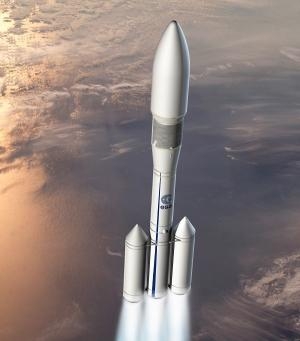Wed, Jul 10, 2013
Heavy-Lift Booster Intended To Guarantee Ongoing Autonomous European Access To Space
In November 2012, European Ministers responsible for space, meeting in Naples, Italy, approved the start of preparatory activities for Europe’s next-generation Ariane 6 launch vehicle. The objective of Ariane 6 is to maintain guaranteed autonomous access to space for Europe, while minimizing exploitation costs and suppressing any support to exploitation.

The performance requested for the new launch vehicle was 3.3–7.1 tons in equivalent geostationary transfer orbit (GTO), to cover both governmental and commercial needs. The general configuration retained was ‘PPH’ – indicating the sequence of stages using solid propulsion, solid propulsion and cryogenic propulsion.
Ministers also requested that the new launch vehicle exploits maximum commonalities with the cryogenic reignitable upper stage of Ariane 5 ME.
Seven months after ESA’s Ministerial Council decision, the project team of ESA, supported by CNES, has endorsed the final concept proposed by industry for the vehicle that will become Europe’s workhorse for reaching space in the 2020s and beyond. This concept was selected after six months of trade-off studies done by a ‘plateau project’ integrating industrial teams (Astrium, Avio, Herakles and the participation of Safran, MT Aerospace and others) working under ESA contract, consistent with Ministerial decisions mentioned above.
The choice of configuration was made by consensus and based on the following main criteria: exploitation costs, time to market and development costs.
Ariane 6 will benefit from the advances by European industry in solid and cryogenic propulsion, structures, systems, avionics, ground segment and operations through the Ariane and Vega programs. The selected ‘Multi P linear’ concept is based on a lower ‘composite’ of four motors, each loaded with around 150 tons of solid propellant, providing also synergies with the Vega evolution perspectives. An "in-line" arrangement of three will serve as the first stage, while the fourth will be mounted above as the second stage. The third stage will be an adapted version of the Ariane 5 ME upper stage, equipped with the Vinci engine and specific propellant tanks. The 15-foot diameter payload fairing will be able to accommodate the same volume of satellites as Ariane 5.
The next step will be for ESA to consult with industry to gather competing ideas on key work packages of the new launch system. Industry will have maximum flexibility for meeting the requirements. Consolidation of the current Phase A will take place at the Preliminary Requirements Review (PRR) in October 2013. Decisions taken by the ESA Council at Ministerial level in November 2012 are being implemented strictly and timely.
More News
An Amazing Experience Awaits The Chosen Few... Oshkosh, to us, seems the perfect place to get started on watching aviation recover the past couple of years... and so ANN is putting>[...]
“NBAA has a tremendous responsibility to the business aviation industry, and we are constantly collaborating with them. Our flight departments, professionals and aircraft own>[...]
Dead Reckoning Dead reckoning, as applied to flying, is the navigation of an airplane solely by means of computations based on airspeed, course, heading, wind direction, and speed,>[...]
Aero Linx: Vertical Aviation Safety Team (VAST) We are a public–private initiative to enhance worldwide flight operations safety in all segments of the vertical flight indust>[...]
We're Everywhere... Thanks To You! Even with the vast resources and incredibly far-reaching scope of the Aero-News Network, every now and then a story that should be reported on sl>[...]
 ANNouncement: Now Accepting Applications For Oshkosh 2024 Stringers!!!
ANNouncement: Now Accepting Applications For Oshkosh 2024 Stringers!!! Aero-News: Quote of the Day (06.13.24)
Aero-News: Quote of the Day (06.13.24) ANN's Daily Aero-Term (06.13.24): Dead Reckoning
ANN's Daily Aero-Term (06.13.24): Dead Reckoning ANN's Daily Aero-Linx (06.13.24)
ANN's Daily Aero-Linx (06.13.24) ANN FAQ: How Do I Become A News Spy?
ANN FAQ: How Do I Become A News Spy?



